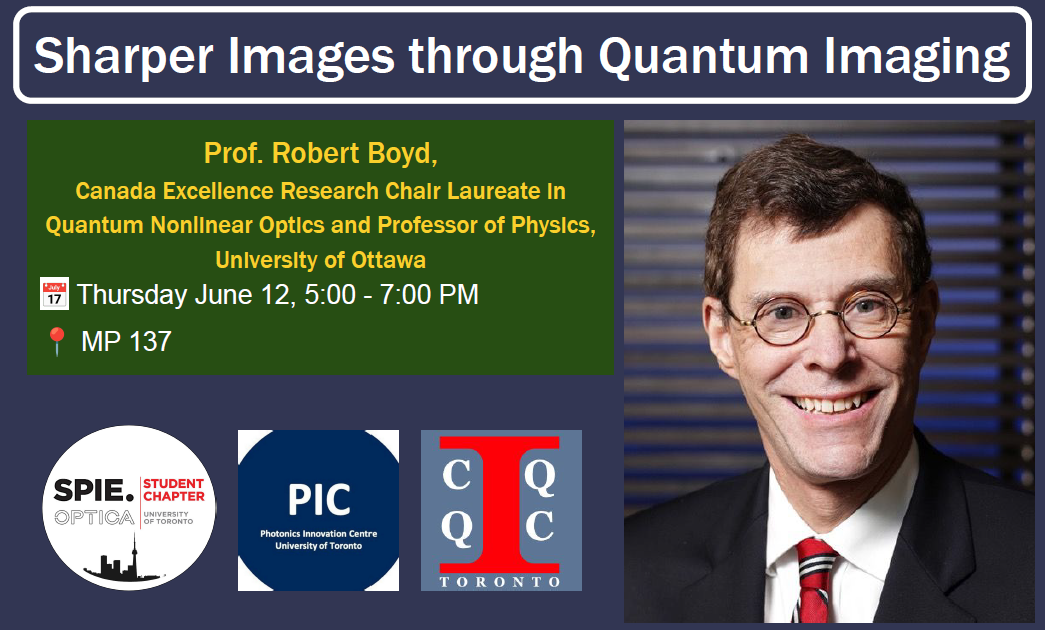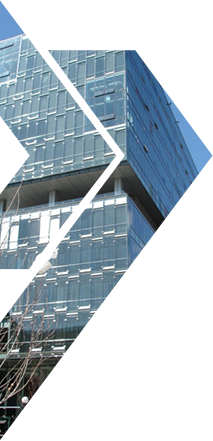
- This event has passed.
Sharper Images through Quantum Imaging (Prof. Robert Boyd)

Title: Sharper Images through Quantum Imaging
Speaker: Prof. Robert Boyd, Canada Excellence Research Chair Laureate in Quantum Nonlinear Optics and Professor of Physics, University of Ottawa
Date and Time: 5-7 pm, Thursday, June 12, 2025, 5-7 PM
Location: MP137, 60 St George St, Toronto, ON M5S 1A7
Abstract: Quantum imaging is a research area that seeks to produce “better” images using quantum methods. The image can be better in one of several different ways. It might possess better spatial resolution, it might display a better signal-to-noise ratio, or it might be able to be formed using a very small number of photons. From an operational standpoint, we can consider quantum imaging to be an imaging modality that seeks to exploit the quantum properties of the transverse structure of light fields. In this presentation, we describe several different recent examples of advances in the field of quantum imaging.
One such example is afforded by quantum phase imaging. Many biological materials, especially cellular materials, possess very small contrasts in terms of the amplitude of a light field transmitted through the material. However, the transmitted field does show significant structure in terms of the phase of the transmitted light. Many of these materials are optically quite fragile and cannot withstand a high-intensity light field. High intensities are required for certain applications such as short-exposure imaging to monitor the dynamical changes in the structure of the material. The problem with optical damage is aggravated through the use of short illumination wavelengths, which are normally required in order to obtain a good spatial resolution of the image. These difficulties can largely be mitigated through the use of quantum imaging methods. For example, quantum imaging can make optimum use of a small number of photons in an image-bearing field. Also, the spatial resolution can be limited not by the wavelength of light being used but by some fraction 1/N of this wavelength, where N is the number of photons in the quantum state that interrogates the object to be imaged. In our work, we were able to achieve a spatial resolution 1.7 times better than that of a classical imaging system with the same numerical aperture. Moreover, the measured phase shift of the light transmitted through the sample was 2.0 times larger than that of a classical imaging system.
Other examples of quantum imaging methods will be described in this talk. Quantum imaging has been shown to be a versatile method for enhancing the performance of optical imaging systems. One can expect additional improvements in imaging performance to be developed in the coming years.
Reference:
1. Black, A. N., L. D. Nguyen, B. Braverman, K. T. Crampton, J. E. Evans, and R. W. Boyd, “Quantum-enhanced phase imaging without coincidence counting,” Optica Vol.10, 952-958, 2023.
Bio: Canada Excellence Research Chair Laureate in Quantum Nonlinear Optics and Professor of Physics, Robert Boyd was born in Buffalo, New York. He received his bachelor’s degree in physics from the Massachusetts Institute of Technology and holds a PhD in physics from the University of California at Berkeley. His PhD thesis was supervised by Charles Townes and involved the use of nonlinear optical techniques in infrared detection for astronomy. In 1977, Professor Boyd joined the faculty of the University of Rochester and, in 2001, became the M. Parker Givens Professor of Optics and Professor of Physics.
In 2010, he became Canada Excellence Research Chair in Quantum Nonlinear Optics and Professor of Physics at the University of Ottawa. His research interests include studies of “slow” and “fast” light propagation, quantum imaging techniques, nonlinear optical interactions, studies of the nonlinear optical properties of materials, and the development of photonic devices including photonic biosensors.
Professor Boyd has written two books, co-edited two anthologies, published over 300 research papers, and been awarded eight patents. He is the 2009 recipient of the Willis E. Lamb Award for Laser Science and Quantum Optics. He is a fellow of the American Physical Society (APS) and of the Optical Society of America (OSA). He has also served as an APS representative and chair of the Joint Council on Quantum Electronics (joint among APS, OSA and IEEE/LEOS). Professor Boyd has served as a member of the Board of Editors of Physical Review Letters and is currently a member of the Board of Reviewing Editors of Science Magazine.

